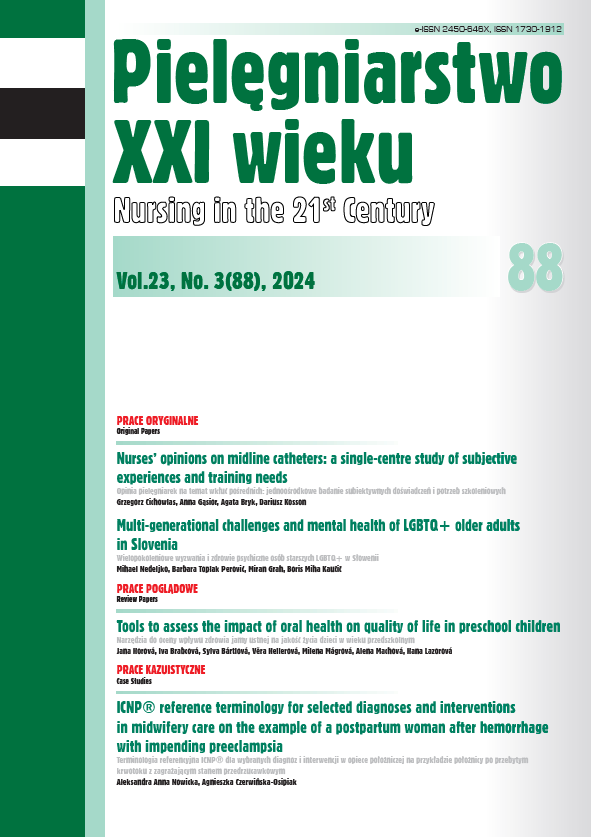Badanie postrzegania wypalenia zawodowego studentów pielęgniarstwa w warunkach klinicznych podczas pandemii COVID
DOI:
https://doi.org/10.2478/pielxxiw-2024-0036Słowa kluczowe:
wypalenie zawodowe, studenci pielęgniarstwa, COVID-19, pandemia, doświadczenie kliniczneAbstrakt
BADANIE POSTRZEGANIA WYPALENIA ZAWODOWEGO STUDENTÓW PIELĘGNIARSTWA W WARUNKACH KLINICZNYCH PODCZAS PANDEMII COVID
Cel pracy. Celem tego badania było poznanie doświadczeń tej grupy studentów, którzy są w grupie wysokiego ryzyka wypalenia zawodowego i niedoboru pielęgniarek. Niniejsze badanie ma na celu ujawnienie postrzegania przez studentów wypalenia zawodowego pielęgniarek i niedoboru pielęgniarek zaobserwowanych podczas kursu klinicznego.
Materiał i metody. Badanie przeprowadzono metodą jakościową z wykorzystaniem konwencjonalnego podejścia do analizy treści. Dane zebrano poprzez przeprowadzenie pogłębionych, częściowo ustrukturyzowanych wywiadów.
Wyniki. Analiza tematyczna transkrypcji wywiadów zidentyfikowała cztery główne tematy, z odpowiadającymi im podtematami: Źródła wypalenia zawodowego, Niepewność, Strategie radzenia sobie, Zróżnicowane wsparcie wydziału podczas rotacji klinicznej. Badanie to dowodzi, że studenci pielęgniarstwa doświadczyli podobnego uczucia wypalenia i napięcia emocjonalnego podczas rotacji klinicznej podczas pandemii COVID-19. Dowody podkreślają wpływ stresu psychicznego na studentów pielęgniarstwa w warunkach pandemii, a dodatkowo stres związany jest z uzyskaniem wszystkich wymaganych kompetencji do ukończenia studiów.
Wnioski. Wyniki tego badania to źródła wypalenia zawodowego takie jak warunki pracy, obciążenie pracą, radzenie sobie z cierpieniem, śmiercią i umieraniem oraz niepewność co do teraźniejszości i przyszłości, w związku z ewaluującym i zmieniającym się rozumieniem pandemii COVID-19. Mechanizmy radzenia sobie z tym problemem to pozytywne nastawienie i rozmowa z rodziną i przyjaciółmi. I wreszcie zróżnicowane opinie studentów na temat emocji i poczucia wsparcia ze strony wykładowców.
Bibliografia
1. Buchan J, Catton H, Shaffer FA. Sustain and retain in 2022 and beyond - international council of nurses. International Council of Nurses; 2022.
2. Dall'Ora C, Ball J, Reinius M, Griffiths P. Burnout in nursing: a theoretical review. Human Resources for Health. 2020;18(1):1-41. https://doi.org/10.1186/s12960-020-00469-9.
3. Burn-out an "occupational phenomenon": International classification of diseases. (2019, May 28). World Health Organization (WHO). https://www.who.int/news/item/28-05-2019-burn-out-an-occupational-phenomenon-international-classification-of-diseases.
4. Hetzel-Riggin MD, Swords BA, Tuang HL, et al. Work engagement and resiliency impact the relationship between nursing stress and burnout. Psychological reports. 2020;123(5):1835-1853. https://doi.org/10.1177/0033294119876076.
5. Arian M, Jamshidbeigi A, Kamali A, et al. The prevalence of burnout syndrome in nursing students: A systematic review and meta-analysis. Teaching and Learning Nursing. 2023;18(4):512-520.
6. Kong LN, Yao Y, Chen SZ, et al. Prevalence and associated factors of burnout among nursing students: A systematic review and meta-analysis. Nurse. Educ. Today. 2023;121:105706. doi: 10.1016/j.nedt.2022.105706.
7. Moser A, Korstjens I. Series: Practical guidance to qualitative research. Part 3: Sampling, data collection and analysis. European journal of general practice. 2018;24(1):9-18. https://doi.org/10.1080/13814788.2017.1375091.
8. Creswell JW. A concise introduction to mixed methods research. SAGE publications, 2024.
9. Sandelowski M. Whatever happened to qualitative description?. Research in nursing & health. 2000;23(4):334-340.
10. Colaizzi P. Psychological research as a phenomenologist views it. [in:] Valle RS, King M. Existential Phenomenological alternatives for psychology. Open University Press: New York, 1978.
11. Sanders C. Application of Colaizzi’s method: Interpretation of an auditable decision trail by a novice researcher. Contemporary nurse. 2003;14(3):292-302.
12. Lincoln Y. Ethical Practices in Qualitative Research. Teoksessa Donna Mertens & Pauline Ginsberg (toim.) The Handbook of Social Research Ethics, 2009.
13. Gray JR, Grove SK, Sutherland S. Burns and grove's the practice of nursing research-Ebook: Appraisal, synthesis, and generation of evidence. Elsevier Health Sciences, 2016.
14. Patton MQ. Enhancing the quality and credibility of qualitative analysis. Health services research. 1999;34(5):1189.
15. Khamisa N, Peltzer K, Oldenburg B. Burnout in relation to specific contributing factors and health outcomes among nurses: a systematic review. Int. J. Environ. Res. Public Health. 2013;10(6):2214-2240. doi: 10.3390/ijerph10062214.
16. Shah MK, Gandrakota N, Cimiotti JP, et al. Prevalence of and Factors Associated With Nurse Burnout in the US. JAMA network open. 2021;4(2):e2036469. https://doi.org/10.1001/jamanetworkopen.2020.36469.
17. Cañadas-De la Fuente GA, Gómez-Urquiza JL, Ortega-Campos EM, et al. Patient-nurse ratio is related to nurses' intention to leave their job through mediating factors of burnout and job dissatisfaction. International Journal of Environmental Research and Public Health. 2019;16(23):4801. https://doi.org/10.3390/ijerph16234801.
18. Gutsan E, Patton J, Willis WK, et al. Burnout syndrome and nurse to-patient ratio in the workplace, 2018.
19. Vuong L. Staffing ratios and burnout. AJN The American Journal of Nursing. 2020; 120(5):13
20. Lai J, Ma S, Wang Y, et al. Factors associated with mental health outcomes among health care workers exposed to coronavirus disease 2019. JAMA network open. 2020;3(3):e203976-e203976.
21. Hu D, Kong Y, Li W, et al. Frontline nurses’ burnout, anxiety, depression, and fear statuses and their associated factors during the COVID-19 outbreak in Wuhan, China: A large-scale cross sectional study. E Clinical Medicine. 2020;24:100424.
22. Mufarrih SH, Qureshi NQ, Hashmi SA, et al. Is the fire even bigger? Burnout in 800 medical and nursing students in a low middle income country. PLoS One. 2024;19(8):e0307309. doi: 10.1371/journal.pone.0307309.
23. Olmos-Bravo ZM, Sánchez-Ortí JV, Grevet EH, et al. Prevalence and associated factors of burnout among health sciences students in Spain - a systematic review. Trends Psychiatry Psychother. 2024. doi: 10.47626/2237-6089-2024-0805.
24. Lindsay J, Cropley S, Benton A, et al. The COVID-19 Lived experience through the eyes of nursing and social work students. Creat. Nurs. 2024;30(2):145-153. doi: 10.1177/10784535241247093.
Pobrania
Opublikowane
Numer
Dział
Licencja
Prawa autorskie (c) 2024 Autorzy

Utwór dostępny jest na licencji Creative Commons Uznanie autorstwa – Użycie niekomercyjne – Bez utworów zależnych 4.0 Międzynarodowe.




